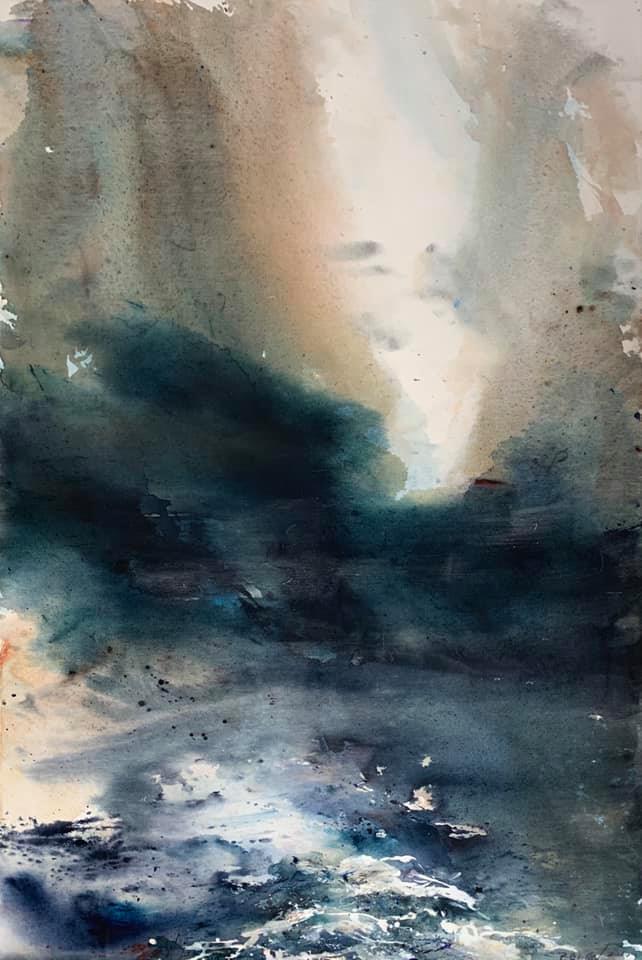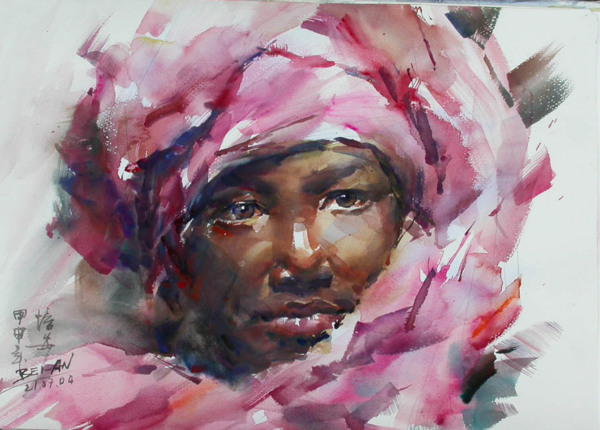Variations between real and unreal, watercolor and acrylic, Europe and China
“You have to master the technique first, then free yourself and become creative”
Caó Beian was born in Shanghai in 1957. He was first a farmer before being admitted to the Academy of Fine Arts in his hometown. Teacher in China for 8 years, he went to Belgium at his own expense to perfect his oil painting technique in 1992. Yet it was for his “Aquarelle de Caó” style that this little master, as mischievous as he was. demanding, receives international rewards at Biennials or Competitions in France and at home, notably at the Nanshan Gallery. To reduce your approach to that of Zao Wou Ki would be to ignore the Chinese artist who is constantly innovating through variations on similarities / dissimilarities of things with the perceived reality and therefore on their part of mystery and unfinished. His works then explore different dimensions of expression: from the most breathtaking realism to the most inspired abstraction, but always slightly figurative, in passing through watercolors where reality is sketched smoothly.
LHCH: How would you talk about the way you paint?
Master Caó: To put it simply, if I paint a waterfall, it will be a waterfall. And, at the same time, it won’t be a stunt!
LHCH: Neither figurative nor abstract?
Master Caó: Yes. And, at the same time, both following the unfolding of my creative process. I have different periods in my job.
LHCH: Let’s start from your last period for the news.
Master Caó: I don’t have a final period (laughs). I am always creating, innovating.
LHCH: The most recent, I meant (laughs). Let’s start with your artistic journey then.
Master Caó: I started out with drawing and painting in a very academic way in China. I would say too academic. But I will come back to that. I had very in-depth painting techniques lessons. According to a European model, very 19th century. I also learned how to design a poster. With all these techniques, I believe I was a good teacher in my Shanghai academy and at the university, architecture section, for almost 8 years.
LHCH: Why did you choose to go to Europe? And especially in Belgium?
Master Caó: Do you know Tintin’s comic book, Le Lotus Bleu? The character Tchang is in fact a real being: Zhang Chongren. This friend of Hergé had studied at the Academy of Fine Arts in Brussels, an institution very recognized in China today! Officially, I wanted to go there to perfect my oil painting technique but, in fact, my dream was to do classical European painting! However, my teacher felt that my technique was sufficient and encouraged me to create my own pictorial language: “Let your creativity run free! “
LHCH: How did you react?
Master Caó: I love calligraphy so I decided to use this gesture through themes of classical Chinese painting, such as “Mountain and water”, but with European abstraction and technique. And a little freedom in the outlook.
LHCH: Your famous “Aquarelle Caó” style?
Master Caó: Yes. I started this style in 1995-1997. He made my reputation for 10 years. Then, around 2009, I moved towards more transparency, poetry and light, playing with thicker layers of acrylic.
LHCH: I had seen works in Paris, at the Maket gallery, in 2014. It is indeed more abstract.
Master Caó: But still figurative with real marine motifs. For the Chinese, the “marvelous”, the “fantastic” is played out between the real and the unreal. We come back to the waterfall.
LHCH: In 2014, your work was also selected for the first China International Watercolor Biennial and some of your works have enriched the collection of the Qingdao Art Museum. Last year, you exhibited at the new small gallery specializing in Chinese art, the Rain Gallery. Along with your work, how do you see your work as a watercolor teacher?
Master Caó: How my paint job. With the difference that today I realized that I hadn’t done too much technique in China, at the Academy. I have a little anecdote that sums up the question of technique and creativity. To a student, one of the first who asked me to take painting lessons, I explained that you first had to know the basics of perspective, the tones of colors, the rhythm of the lines, etc. But she preferred not to do “too much technique” and go directly to “creation”. I had asked him: “Can I speak French well?” “. ” No ! I understand you but your grammar is very bad, ”she replied. “Ah, so can I say that I have creative French? (Laughs).
LHCH: Funny. What lesson do you remember from it?
Master Caó: Young Europeans often want to abstract for ease. Without having any bases in drawing or painting. Abstract art is not easy. Line, point, surface … and all of this carried away by calligraphy gestures (for me), acceleration and deceleration, light or strong lines, more or less thick layers of paint, etc … It is very subtle.
LHCH: Your creations this year? There is calligraphy and like music in your 2020 paintings.
Master Caó: Yes, since March-April. I was also a professor of calligraphy for 10 years at the Confucius Institute in Brussels. So, yes, I’m still good at it (laughs).
LHCH: Thanks to artists like you, our young people will be pulled to the top.
Master Caó: In my opinion, an artist-painter must, in order to be fulfilled and therefore free his expression, to master the basics of music; know literature and, above all, poetry; understand aesthetics and philosophy.
LHCH: If you had to quote two Belgian painting masters who influenced you?
Master Caó: Pierre Alechinski and Constant Permeke, above all. Belgium hides treasures!



